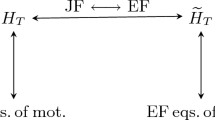Abstract
We address the curious problem of quadratic Zeeman effect at the classical mechanical level. The problem has been very well understood for decades, but an analytical solution of the equations of motion is still to be found. This state of affairs persists because the simultaneous presence of the Coulombic and quadratic terms lowers the dynamical symmetry. Energy and orbital angular momentum are still constants of motion. We find the exact solutions by introducing the concept of an image ellipse. The quadratic effect leads to a dilation of space-time, and a one-to-one correspondence is observed for pairs of physical quantities like energy and angular momentum, and the maximum and minimum distances from the Coulomb center for the Zeeman orbit and the corresponding pairs for the image ellipse. Thus, instead of finding additional conserved quantities, we find constants of motion for an additional dynamics, namely, the image problem. The trajectory is open, in agreement with Bertrand’s theorem, but necessarily bound. A stable unbound trajectory does not exist for real values of energy and angular momentum. The radial distance, the angle covered in the plane of the orbit, and the time are uniquely determined by introducing further the concept of an image circle. While the radial distance is defined in a closed form as a transcendental function of the image-circular angle, the corresponding orbit angle and time variables are found in the form of two convergent series expansions. The latter two variables are especially contracted, thereby leading to a precession of the open cycles around the Coulomb center. It is expected that the space-time dilation effect observed here would somehow influence the solution of the quantum mechanical problem at the non-relativistic level.
Similar content being viewed by others
References
F H J Cornish, J. Phys. A17, 323 (1984)
J E Avron, W Herbst and B Simon, Ann. Phys. 114, 431 (1978)
H C Praddaude, Phys. Rev. A6, 1321 (1972)
M L Zimmerman, M M Kash and D Kleppner, Phys. Rev. Lett. 43, 1092 (1980)
D Herrik, Phys. Rev. A26, 323 (1982)
M A Al-Laithy, C M Farmer and M R C McDowell, Phys. Lett. A108, 144 (1985)
G Hose, H S Taylor and D Richards, J. Phys. B18, 51 (1985)
S Saini and D Farrelly, Phys. Rev. A36, 3556 (1987)
K D Krantzmann, J A Miligan and D Farrelly, Phys. Rev. A45, 3093 (1992)
E Oks, Eur. Phys. J. D28, 171 (2004)
S N Datta and A Misra, Int. J. Quantum Chem. 82, 209 (2001)
Author information
Authors and Affiliations
Rights and permissions
About this article
Cite this article
Datta, S.N., Pandey, A. Exact solution of the classical mechanical quadratic Zeeman effect. Pramana - J Phys 68, 967–982 (2007). https://doi.org/10.1007/s12043-007-0096-3
Received:
Accepted:
Published:
Issue Date:
DOI: https://doi.org/10.1007/s12043-007-0096-3




